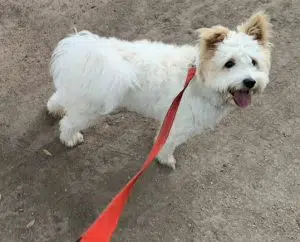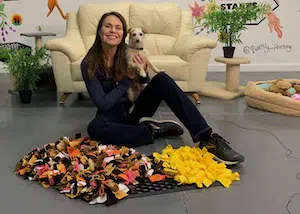
How many times have you seen a dog tied up waiting for its owner outside the shops and gone straight up to pat it on the head, or stick out your hand to say ‘hi’, thinking you know how to approach a dog?
I daresay most people have done this many times in their life. Knowing what I know now, I would also say that most of us were completely unaware about how many dogs we distressed doing this (whilst thinking we were being nice) and how many of us were close to having our hand or leg bitten by an otherwise friendly dog because we simply did not know how to approach a dog the right way.
Depending on your generation, you may have been told the best way to approach a dog is to stick out your hand and let them sniff it first. Fortunately, we are starting to understand that this could actually be an invitation for a bite. Particularly, with so many dogs suffering from anxiety and fear-based aggression issues in an increasingly hectic, over populated (humans and dogs) and confronting environment.
I won’t go into the causes or side effects of fear-based aggression here, there’s an article about that here. But when it comes to the best way to approach a dog, here’s some tips on what to do, and what NOT to do.
Firstly, if you meet an owner with their dog or you see one tied up alone outside a shop the same rule should apply. ALWAYS invite the dog to say hi to you first.
We’re not always good as humans at reading each other’s body language, and when it comes to a dog we’re even less so. It’s best to err on the side of caution with a dog, because at least a person is much less likely to bite you if you greet them a little too enthusiastically.
Turn to your side, pat your leg and encourage them to come over, if they do, then gently give them a tickle under the chin and a pat to say hi. But, if they don’t or they move away, leave them alone!!
If you see a dog tied up and it’s owner is not around, NEVER go up and touch it as it may already be feeling a bit anxious, and if you miss the warning signs and continue to invade their space, they may feel threatened (particularly if they feel like they can’t escape as they are tied up) and could bite. Not to mention the stress this places on the dog in the first place.
If the owner is around for you to ask if it is okay to pat their dog and they say yes, just be mindful that the owner may also not be good at reading their own dog’s body language, so it is still advisable to move in slowly, turn to your side and invite them over to say hi to you. We all have our bad days…and so can dogs!
Also, it is always best to scratch them under the chin rather than putting your hand over and on top of their head, which can be seen as an intimidating action to the dog.
Finally, it is always useful to try to observe the body language of a dog when having any interaction. Signs we should look for to see if a dog is anxious or fearful (and therefore could possibly react with fear based aggression to you and other dogs) include:
It is far more beneficial for people to be aware of this lead up body language, rather than just the more obvious warning signs such as growling, baring teeth, barking and/or lunging, so that measures can be taken to remove the ‘trigger’ (person, other dog, object) as early as possible in the behaviour chain before it escalates into lunging at, or biting, someone.
The importance of this is to not only stop a person from being injured, but to also stop this behaviour from being inadvertently rewarded (as the person or dog usually moves away / removes the threat) which, in the dog’s mind, reinforces that this is the correct action to take when they feel threatened.
To learn more about fear-based aggression read here and to see the video about inadvertent reinforcement click here, OR read more about how we often ‘reward’ bad behaviour click here.
Lara Shannon is a certified dog behaviourist and trainer, pet food nutrition specialist, Executive Producer and Host of Pooches at Play on Channel 10 and editor of Poochesatplay.com. Lara also runs her own dog training business in Melbourne’s Bayside area and is the Author of World of Dogs and Eat, Play, Love Your Dog


Walking a dog – how much and why

The benefits of Snuffle Mats for dogs


Toilet Training a Puppy for success


Get your paws on Lara Shannon’s best selling books ‘Eat, Play, Love (your dog) and World of Dogs.
Available in Australia, USA, UK and Canada.